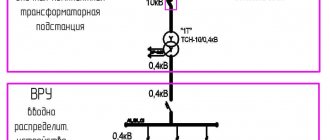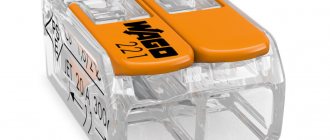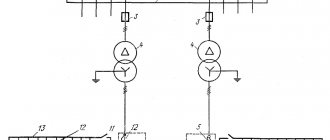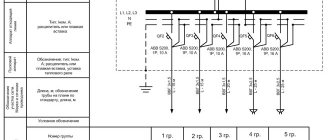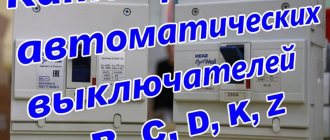In accordance with the PUE (clause 1.2.18-20), with regard to ensuring the reliability of power supply, power receivers are divided into three categories.
Category 1 power receivers are those devices, the interruption of power supply to which can entail danger to human life, significant damage to the national economy, damage to expensive capital equipment, mass defects of products, disruption of a complex technological process, disruption of the functioning of particularly important elements of public utilities. The power supply for such electrical receivers must be provided from two independent sources; a break is allowed only for the period of automatic power restoration.
Categories of reliability of power supply of a building/facility
There is a table that displays the reliability category of residential buildings, dormitories, institutional buildings and facilities:
- A residential building with electric stoves is classified in group 2.
- A house with 8 apartments and electric stoves is group 3.
- Garden plots – 3.
- Room with fire-fighting equipment – 1.
- A dormitory where more than 50 people live – 2. Less than 50 – 3.
- Individual heating point and central heating point – 1.
- Buildings where more than 2 thousand people work – 1.
- High-rise buildings more than 16 floors – 1.
- Sanatorium buildings and rest houses – 1.
- Gosstrakh and financial institutions with security alarms and fire-fighting devices - 1.
- Libraries with security equipment – 1.
- Libraries where one thousand copies of books are stored – 2.
- Safety of book copies up to 100 units – 3.
- Preschool and school institutions with security equipment – 1.
- Hotels with security and fire safety equipment – 1.
- Canteens, cafes and other premises for eating - 1.
- Public service buildings (hair salons with more than 15 people, studios with 50 people and dry cleaners with a capacity of 500 kg) – 2.
- Museums of federal, regional and republican significance – 1.
- Medical buildings with intensive care, operating room, ward for premature babies - 1.
- Temporary objects – 3.
A building that has group 3 and is powered through one line should have security and fire equipment connected to autonomous sources.
Transformer substations are used for public buildings, built-in or attached.
A residential building can be powered by attached substations only if they are filled with liquid dielectric.
The use of TP in residential buildings and school buildings is prohibited.
The TP should be placed in such a way that there is round-the-clock access for organizations and personnel involved in maintenance.
Area of responsibility
The supplier is responsible for the reliability and quality of supplied electricity. The amount of liability is determined by the degree of negative consequences of a power outage by the civil legislation of the Russian Federation, as well as by the legislation of the Russian Federation on energy. The power supply contract specifies all the conditions for the supply of electricity, as well as reliability categories. If these conditions are not met and thus cause great financial damage to the consumer, the consumer has the right to demand compensation in court.
Thus, to prevent misunderstandings, it is necessary to specify the degree of responsibility for violation of the reliability of power supply. Without this clause, it will be quite difficult to obtain compensation for damage, since the PUE rarely touches on these nuances. But if such a situation arises and if there is an agreement with the specified clause, the consumer has the right to apply for reimbursement of expenses to the electricity supplier.
Third category of power supply reliability
This group included all other electrical receivers that did not fall into either the first or second categories. For household consumers, these are residential areas and houses. For industry - workshops where there is no serial production of products or auxiliary workshops. This group allows an interruption in power supply for the time necessary to repair (replace) electrical equipment, but should not exceed more than 1 day. When designing the power supply for these devices, it is necessary to take into account the methods of laying cables, redundancy of the transformer (when replacing the transformer), so that the repairs are completed within the time limits specified in the PUE.
It can be concluded that when designing a power supply system for both an industrial enterprise and household consumers, it is necessary to take into account the influence of various factors that will influence the reliability category. Also, analyze the responsibility and purpose of electrical receivers, their role in the technological (household) process, and the permissible power interruption time.
Who determines
The category of power supply is determined by the designer during the creation of the facility's power supply system, according to the technical part of the project and according to such regulatory documents as PUE. The consumer also has the right to determine the category of power supply necessary for the normal functioning of the enterprise. When choosing category I or II, it is worth considering that the cost of electricity will increase significantly.
The most economical, but least suitable for production, would be the choice of category III. But signing an agreement with a lower categorization of the object relieves the supplier of responsibility for the undersupply of electricity and the loss caused in connection with this.
When drawing up an agreement for connecting electricity, it is important to take into account some nuances:
- power supply reliability category;
- required quantity and quality of electricity;
- price per kWh and the procedure for determining it;
- calculation method;
- definition of an electricity monitoring device;
- terms of payment by the consumer for electricity;
- guarantee of consumption by the consumer of the declared amount of electricity at a specified time;
- access to electricity supplier representatives to metering devices and electrical equipment to check them;
- number and duration of planned outages from the power supply network.
Which electrical receivers belong to the first category electrical consumers
In order to correctly determine the category, you need to know about the types and power of electrical receivers used by the consumer.
Electrical receivers and their types
Electrical receivers are not part of the power supply system, but are necessarily taken into account when designing it. They are used both in production and in everyday life. They all differ in technical characteristics, power consumption and operating modes.
The main part of the EP is divided into four groups:
- Electric motors are the most common type of electric motors, belonging to the first group according to their purpose. DC electric drives are used in installations without speed control - these are quite powerful synchronous and asynchronous motors. Asynchronous motors, despite the advantages of synchronous ones, are most common due to their ease of control and low cost. The power of such electrical receivers consumes about 70% of the total power of the entire enterprise.
- The second group is electrotechnological and electrothermal installations. In combination with the first, it is considered a power load. The second group accounts for 20% of the total capacity. The most common electrical receivers of this group are arc and induction furnaces, resistance furnaces, dielectric heating installations, welding machines, electrolysis, galvanic and high-voltage electrostatic installations.
- The third group of electrical receivers includes electrical lighting installations with various types of lamps. The consumption share of the lighting load is at most several tens of percent.
- The fourth group includes information processing and management devices. This group is demanding regarding the reliability of power supply, but consumes a small amount of power.
Electrical receivers are also divided according to other criteria:
- By type of current. These are electric motors powered by alternating current (for most enterprises, a frequency of 50 Hz is relevant - in this case, such alternating current is called industrial frequency current; there are also currents of high and low frequency), direct current and pulsed.
- By rated voltage: up to 1 kV and more than 1 kV. Taking these groups into account is very important for the design of the electrical supply system and its safety.
- By number of phases: one-, two- and three-phase electrical receivers. But they are all powered from a three-phase network; single-phase electrical receivers require a neutral (neutral wire).
- According to load schedules: long-term, short-term, intermittent. The load schedule of powerful electric motors is called abruptly variable, because during their operation the load power increases almost to emergency limits and can cause quite strong voltage fluctuations.
- By type of rated power: kW and kVA.
- According to the neutral mode: solidly grounded, isolated, grounded through active resistance, compensated inductive.
Categories for power supply reliability
Reliability requirements are different for all electrical receivers.
The degree of reliability ensures stable operation of the enterprise and determines the minimum permissible time of power supply interruption. In chapter 1.
2 of the Rules for the Construction of Electrical Installations (PUE) describes three categories of electrical installations for the reliability of power supply:
- I category of reliability. This includes electronic devices, the shutdown of which poses a threat to human life and the security of the Russian Federation, large financial losses, interruption of a difficult-to-install production process, and failure of the functioning of elements such as television and communication facilities. The power supply for this category is provided by two independent sources, which serve as a reserve for each other. This category also includes electrical receivers, the failure of which can cause an industrial accident, entailing a high risk of injury and death, and fires. They are combined separately into a special group of category I, which requires a third power source. Its presence provides even more reliable protection against power outages. Lack of power supply is possible during the automatic switching on of the reserve.
- II category of reliability. It includes electrical receivers, the shutdown of which significantly affects production, causing a large loss in the form of loss of the ability to produce products, downtime for the majority of the enterprise’s employees, machinery, and transport; disruption of life in a large number of residential areas. For this category, as well as for the first, power is provided using two independent sources, but interruptions in power supply here are permissible for the duration of manual switching on of the reserve (with the help of teams).
- Reliability category III includes electrical receivers that are not included in the first two categories. Power is supplied from a single source, the maximum permanent interruption of power supply is 24 hours. The maximum duration of a power outage in one year is 72 hours. There are exceptions for longer periods, which are agreed with all necessary services.
